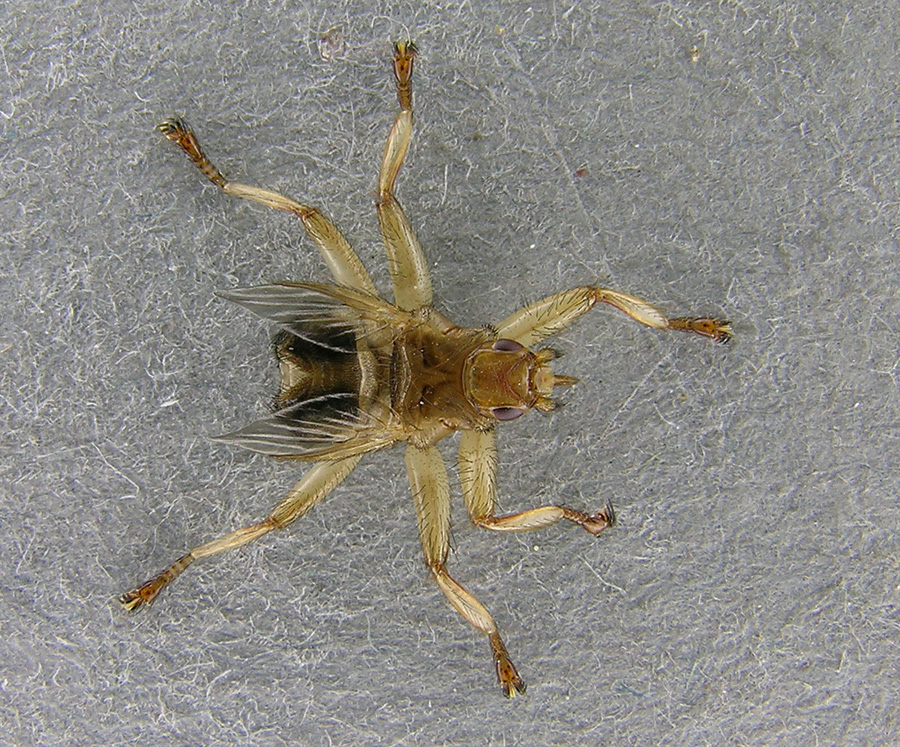- Hippoboscidae
__NOTOC__Taxobox
name = Louse flies, keds

image_width = 240px
image_caption = The flightless "Crataerhina pallida "
regnum =Animal ia
phylum =Arthropod a
classis =Insect a
subclassis =Pterygota
infraclassis =Neoptera
superordo =Endopterygota
ordo = Diptera
subordo =Brachycera
infraordo =Muscomorpha
zoosectio =Schizophora
zoosubsectio =Calyptratae
superfamilia =Hippoboscoidea
familia = Hippoboscidae
subdivision_ranks =Genera
subdivision =Many, see text
synonyms =Hypoboscidae ("lapsus ")Hippoboscidae, the louse flies or keds are obligate
parasites ofmammals andbirds . In this family there are wingedspecies which can fly at least reasonably well, as well as others with vestigial or no wings which areflightless and highlyapomorph ic. As usual in theirsuperfamily Hippoboscoidea , most of thelarva l development takes place within the mother's body, andpupation occurs almost immediately.The sheep ked, "
Melophagus ovinus " , is a wingless, reddish-brown fly that parasitizessheep . The Neotropical deer ked, "Lipoptena mazamae " , is a commonectoparasite ofwhite-tailed deer ("Odocoileus virginianus") in the southeastern United States. Both winged and wingless forms may be seen. A common winged species is "Hippobosca equina ", called "the louse fly" among riders. Species in other genera are found on birds, for example, "Ornithomya bequaerti " has been collected from birds inAlaska . Hippoboscidae are also common parasites of theTawny Frogmouth ("Podargus strigoides") of Australia."
Pseudolynchia canariensis " is commonly found onpigeon s anddove s, and can serve as the vector ofpigeon malaria . There is some evidence that other Hippoboscidae can serve as vectors of disease agents to mammals.ystematics
In some obsolete taxonomies, the name Hippoboscidae is applied to the group properly known as
Pupipara , i.e. the present family plus the bat flies (Nycteribiidae and "Streblidae "). It has been shown that two of the three traditionalsubfamilies (Hippoboscinae andLipopteninae ) are goodmonophyletic groups at least by and large. According tocladistic analysis of severalDNA sequence s, to make theOrnithomyinae monophyletic their tribeOlfersini deserves to be recognized as a full-blown family too. [Petersen "et al." (2007)]elected genera
* "
Austrolfersia "
* "Crataerhina "
* "Hippobosca "
* "Icosta "
* "Lipoptena "
* "Melophagus
* "Microlynchia "
* "Myophthiria "
* "Neolipoptena "
* "Olfersia "
* "Ornithoctona "
* "Ornithoica "
* "Ornithomya "
* "Ornithophila "
* "Ortholfersia "
* "Pseudolynchia "
* "Stenepteryx "
* "Stilbometopa "
* "Struthiobosca "ee also
*
Use of DNA in forensic entomology Footnotes
References
* (2007): The phylogeny and evolution of host choice in the Hippoboscoidea (Diptera) as reconstructed using four molecular markers. "Mol. Phylogenet. Evol." 45(1): 111–122. doi|10.1016/j.ympev.2007.04.023 (HTML abstract)
External links
* [http://elibrary.unm.edu/sora/NABB/v017n02/p0065-p0068.pdf Incidence of Louse-flies (Hippoboscidae) in Some Alaskan Birds]
* [http://ipm.ncsu.edu/AG369/notes/sheep_ked.html Sheep Ked]
* [http://creatures.ifas.ufl.edu/livestock/deer_ked.htm Neotropical Deer Ked]
* [http://edis.ifas.ufl.edu/IN584 Pigeon Louse Fly]
* [http://www.merckvetmanual.com/mvm/index.jsp?cfile=htm/bc/204805.htm "Pseudolychia canariensis" as Vector of Pigeon Malaria]
* [http://www.pubmedcentral.nih.gov/articlerender.fcgi?artid=522062#r18 Hippoboscidae as Potential Vectors of "Bartonella" spp.]
* [http://bugguide.net/node/view/13354 Photograph of A Louse Fly]
*Images from Diptera.info. [http://www.diptera.info/photogallery.php?photo_id=644]
*Images from BugGuide [http://bugguide.net/node/view/13382]
* [http://creatures.ifas.ufl.edu/livestock/pigeon_fly.htm "Pseudolychia canariensis", pigeon louse fly] on theUF / IFAS Featured Creatures Web site
* [http://creatures.ifas.ufl.edu/livestock/deer_ked.htm "Lipoptena mazamae", Neotropical deer ked] on theUF / IFAS Featured Creatures Web site
Wikimedia Foundation. 2010.
